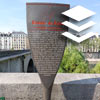One of the series of signs describing historical places in Paris. The signs were placed starting in 1992 and are also called sucettes Starck (Starck’s Lollipops) after Philippe Starck who designed them.
The sign describes the building where the town hall of the second district was and where Napoleon married Josephine
The house used today by the Bank of Paris and Holland (Paribas) was photographed on the same day
 Click for a larger image
Click for a larger image The illustration in the center of the sign is shown here at magnification
 Click for a larger image
Click for a larger image The house is noted as a French historical heritage site
Additional signs on the house indicate the wedding of Napoleon and Joséphine
 Click for sign's details Translation of the text on the sign
Click for sign's details Translation of the text on the sign:
[An illustration of a ship, symbolizing the symbol of Paris]
History of Paris Hôtel de Mondragon Opened in 1713 on the site of the Vendôme bastion of Louis XIII’s enclosure, Rue d’Antin was quickly developed and lined with beautiful residences. The most prestigious, built in 1720, is inhabited by Etienne Bourgeois de Boynes, treasurer of the Bank of Law. In 1754, this hotel was purchased by Duval de l’Epinoy, who offered it to his daughter, Marquise de Mondragon. Confiscated in 1793, the hotel housed the town hall of the second arrondissement from 1795 to 1833.
[Illustration of the building]
Napoleon Bonaparte married Joséphine de Beauharnais there on March 9, 1796. In 1869, the newly created Banque de Paris moved into the building. Became the Bank of Paris and the Netherlands in 1871, it is today Paribas.

 Click for a larger image
Click for a larger image  Click for a larger image
Click for a larger image  Click for sign's details
Click for sign's details  Click for all signs belonging to The History of Paris (Starck's Lollipops)
Click for all signs belonging to The History of Paris (Starck's Lollipops)
 167 Meter |
167 Meter |  176 Meter |
176 Meter |  198 Meter |
198 Meter |  210 Meter |
210 Meter |  211 Meter
211 Meter